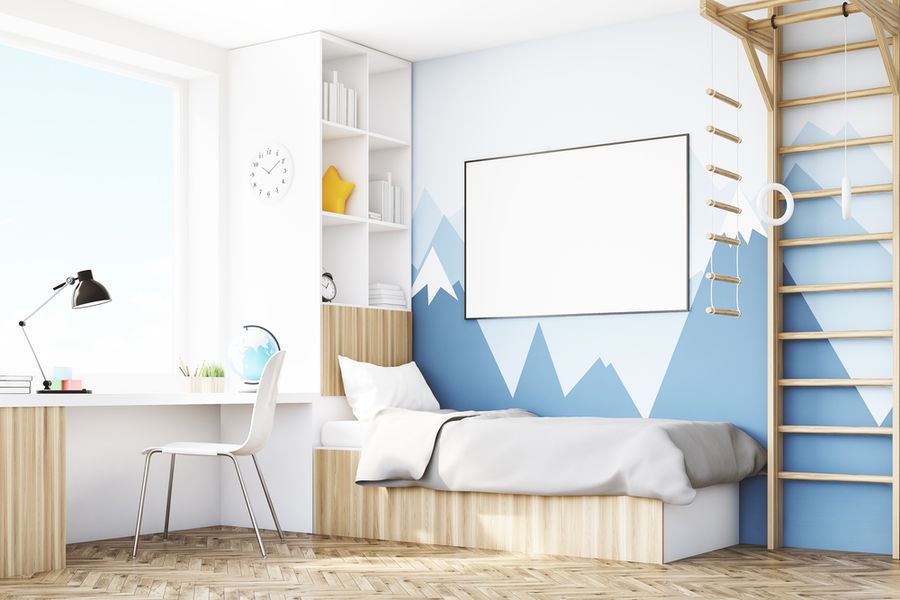
Getting ready to decorate (or redecorate!) a bedroom for your big kid? You might want to forget the bright primary colors and character-patterned bedding if you expect the space to prime your kiddo for a good night's sleep.
“A child’s bedroom should be a haven, a space they love spending time in, where they feel safe as they drift off to sleep, and comforted by what they see when they wake up in the morning,” says interior designer Carolyn Feder, founder and owner of Sensory Interior Design in Dallas. “The elements are crucial for their mental and physical health, especially now when we live in a crazy, fast-paced world filled with overstimulation beyond compare. A healthy bedroom is where the mind, body, and soul re-calibrate.”
Not sure where to start? Check out these tips for how to style a soothing space:
Plan for the Light
"Lighting is the first and most important element we discuss in every project," Feder says. "[Choose] full-spectrum light bulbs, available in all kinds of configurations, not fluorescent tubes or spiral bulbs," she advises. "Poor lighting—too warm or yellow and too cold or blue white—causes anxiety and depression."
While you want to let the natural sunlight in during the day to encourage a happy mood, lighting at other times should be subdued to encourage quiet and rest. To transition from day to night, consider adding dimmer switches and attachments with three levels of intensity to overhead lighting as well as floor and table lamps, Feder suggests, and choose the right window treatments.” There are so many choices, everything from delicate light-filtering shades and sheers to certain blinds and draperies that offer complete black-out,” she says. (Safety note: Just make sure you choose cordless window coverings!)
Consider the Acoustics
While good insulation inside the bedroom's walls is necessary to muffle sounds from outside the room, the decorating materials you use within your child's bedroom are also a factor, Feder says. "To prevent sound from bouncing all over a room, we suggest having natural wood floors with throw rugs or carpet, versus tile and laminated surfaces. Wood blinds, soft shades, and draperies are preferable over metal or plastic blinds."
Embrace Color Psychology
There’s a reason nurseries have long been designed in pale pink, baby blue, or soft yellow—they are soothing hues. So, while you might want to buck the trends or honor your son’s love of fire engines, bright reds and other bold colors are too stimulating to be good choices for a calming kid’s room.
A better option is to create a base of soft neutrals like grays and taupes mixed with pastel colors—try lavender and celery green if you want to avoid the standard pink and blue. Also avoid high-contrast palettes and busy patterns on walls, bedding, or rugs or risk making your child feel energized instead of relaxed.
Bring the Outside In
"Using and designing around natural elements sends a subliminal message to the brain to feel calm," Feder says. "The colors, sights, sounds, scents, and textures found in nature present the most perfect balance and are the greatest source of inspiration for all my schemes."
One way to bring nature inside is to incorporate images of the outdoors into your child's bedroom. "Especially when working with children, wall art should be photography over paintings," Feder says. "Photos help children learn how to observe details around them and they learn how to appreciate everything nature does for us as a whole. Photos can also double as lovely views when windows with lovely vistas aren't available."
Make It Cozy
Kids love to cuddle, so fill your child's room with items she can use to self-soothe, like a large stuffed animal or body pillow to lounge on, or a soft blanket with enough weight to feel like a hug. Bedding, pillows, and rugs should be soft to the touch, of course, so "test-drive" all materials before bringing them into the room.
Another item that can make kids feel cozy? Family photos. Seeing the faces of their loved ones surrounding them in their bedroom makes children feel safe and relaxed.
Limit Stimulation
"A crowded and messy child's bedroom is highly disruptive to sleep patterns—even with the lights off," Feder says. "Plain and simple, chaos causes sensory overload which leads to anxiety."
Keep toys, clothes, and other supplies in covered boxes, baskets, or cupboards to avoid overstimulation caused by clutter. Plus, enforcing a screen-free-bedroom rule will eliminate that potential distraction as well as brain-stimulating blue light emissions.
Arrange Furniture Wisely
"To help parents remember the elements needed for a healthy and well-balanced bedroom, I developed the acronym SPEL—Sleep, Play, Enjoy, Learn," Feder says. "Every room should be able to provide all these functions." In her system, each activity is given its own distinct zone but the room's primary functions of relaxation and sleeping are given the most attention.
"Proper placement of beds, storage, toys, desk, etc. varies from room to room and with the child's age, but one thing is certain, the positioning of these stations and the colors, finishes, lighting, and scents will make a big difference in how the room is perceived and used."
